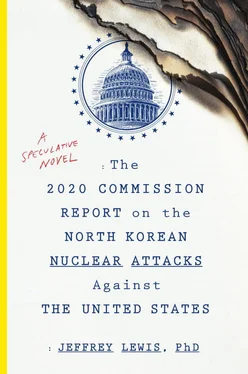Jeffrey Lewis - The 2020 Commission Report on the North Korean Nuclear Attacks Against the United States
Здесь есть возможность читать онлайн «Jeffrey Lewis - The 2020 Commission Report on the North Korean Nuclear Attacks Against the United States» весь текст электронной книги совершенно бесплатно (целиком полную версию без сокращений). В некоторых случаях можно слушать аудио, скачать через торрент в формате fb2 и присутствует краткое содержание. Город: New York, Год выпуска: 2018, ISBN: 2018, Издательство: Mariner Books, Жанр: Фантастика и фэнтези, Триллер, на английском языке. Описание произведения, (предисловие) а так же отзывы посетителей доступны на портале библиотеки ЛибКат.
- Название:The 2020 Commission Report on the North Korean Nuclear Attacks Against the United States
- Автор:
- Издательство:Mariner Books
- Жанр:
- Год:2018
- Город:New York
- ISBN:9-781-328-57391-9
- Рейтинг книги:4 / 5. Голосов: 1
-
Избранное:Добавить в избранное
- Отзывы:
-
Ваша оценка:
- 80
- 1
- 2
- 3
- 4
- 5
The 2020 Commission Report on the North Korean Nuclear Attacks Against the United States: краткое содержание, описание и аннотация
Предлагаем к чтению аннотацию, описание, краткое содержание или предисловие (зависит от того, что написал сам автор книги «The 2020 Commission Report on the North Korean Nuclear Attacks Against the United States»). Если вы не нашли необходимую информацию о книге — напишите в комментариях, мы постараемся отыскать её.
The 2020 Commission Report on the North Korean Nuclear Attacks Against the United States — читать онлайн бесплатно полную книгу (весь текст) целиком
Ниже представлен текст книги, разбитый по страницам. Система сохранения места последней прочитанной страницы, позволяет с удобством читать онлайн бесплатно книгу «The 2020 Commission Report on the North Korean Nuclear Attacks Against the United States», без необходимости каждый раз заново искать на чём Вы остановились. Поставьте закладку, и сможете в любой момент перейти на страницу, на которой закончили чтение.
Интервал:
Закладка:
SECTOR COMMANDER: Okay.
ANTI-AIR COMMAND: Don’t shoot unless it comes into our airspace.
SECTOR COMMANDER: Okay, we’ll shoot if it comes in our airspace.
The order handed down to the SA-5 unit from Chunghwa reflected standing orders to shoot down foreign aircraft that entered DPRK without permission. In 1994, when a US helicopter strayed into DPRK airspace, the North Koreans shot it down. Until now, none of the US bomber missions had crossed this threshold—but clearly Kim’s air commanders were on alert for such an incursion.
As the aircraft turned westward, the SA-5 unit handed tracking of the target over to another missile unit, this one deployed near the city of Ongjin. The crew of this unit was inexperienced. They had been deployed with a brand-new system, which the North Koreans called the Pongae-5 surface-to-air missile. One member of the crew, Roh Pyong-ui, was captured as a POW and subsequently debriefed. “It was the first time we had seen such a target in real life,” Roh said. “It looked just like training.”
Within the US intelligence community, the Pongae-5 SAM was known as the KN-06. North Korea had begun development on it in 2009, but that effort was plagued with problems, as were the attempts to construct the missile’s accompanying radar and engagement software. When North Korea announced mass production of the KN-06 in May 2017—“to be deployed all over the country like forests”—North Korean state media openly referenced the “defects” that had slowed its development.
As a consequence of the delays in the missile system’s development, the KN-06 unit that now took over the tracking of BX 411 had only begun training with the new system in February 2020, just after the lunar new year. This training was cut short following the eleventh and penultimate SCATHE JIGSAW bomber flight on March 6, at which point military authorities rushed the KN-06 unit to Ongjin.
The deployment of the unit seems to have been part of a general repositioning of North Korean air defenses using a limited number of KN-06 batteries. Following the initiation of SCATHE JIGSAW, North Korea probably repositioned the units to prevent their locations from being compromised by air probes. A minority within the US intelligence community believed that North Korea was positioning KN-06 units to improve the chances of shooting down an American aircraft.
But in either case, the pressure on the inexperienced crew of the KN-06 unit near Ongjin explains why they behaved as they did in the crucial minutes that followed their acquisition of the unidentified target. The sector commander made contact with the unit, passing along identifying information about the target and reiterating the standing order to shoot down any American aircraft that crossed into North Korean airspace. Communications intercepts show that the call, by radio, was hurried and brief:
SECTOR COMMANDER: American bomber coming into your sector, heading 275 degrees.
KN-06 UNIT: Okay, shoot it?
SECTOR COMMANDER: If you see it cross, shoot it.
KN-06 UNIT: Okay, if we see it, we will shoot it.
SECTOR COMMANDER: If it crosses. Don’t lose it.
KN-06 UNIT: Okay. We won’t.
The original Korean transcript leaves some doubt about whether the KN-06 crew understood that the order was a reiteration of a standing order to shoot aircraft that entered DPRK airspace without permission, or whether the crew believed that it was being told by the sector commander that BX 411 had already violated North Korean airspace and should be shot down if an opportunity presented itself. What is certain is that the KN-06 had a FLAP LID tracking and engagement radar that provided little information to the missile’s operators about what they were targeting. Thus, the KN-06 crew continued operating under the assumption that Air Busan Flight 411 was a bomber—rather than a jetliner with a payload of schoolchildren.
Neither can there be any doubt about what happened next. The missile unit at Ongjin tracked BX 411 out over the Yellow Sea. At 12:28 AM, the unit fired two surface-to-air missiles at its target. The first missile struck the Airbus A320 near the tail section, tearing the fuselage in two and sending the aircraft into the sea.
It remains unclear why the KN-06 crew concluded that the BX 411 had crossed into North Korean airspace and then chose to down the aircraft. Roh Pyong-ui, in his interrogation, insisted both that the aircraft had violated North Korean airspace and that it was a military aircraft sent as a provocation by the Trump administration. “We received an order that an American bomber was violating our airspace,” Roh told his interrogator. “For us, that is everything. It means we need to shoot it down.” Roh was asked repeatedly whether his crew made the determination itself that the aircraft had crossed into North Korean airspace or whether he understood the sector commander to have made that judgment. Each time, without answering the question, Roh insisted that the aircraft had violated North Korean airspace.
Roh also insisted that the aircraft was an American bomber or another type of military aircraft, despite being shown evidence that the aircraft was a civilian airliner. “That means nothing,” he responded when interrogators told him the aircraft was a civilian Airbus 320. “It is easy to turn a civilian type of plane into one for military use. We did it all the time.”
While it is impossible to understand what the North Korean crew was thinking, it is clear in retrospect that they were primed to see a bomber. The crew had specifically been moved to this location in the expectation of an American bomber flight; the crew was then told that the aircraft was a bomber; and in fact the aircraft was retracing, however inadvertently, the flight path expected for an American bomber. In the confusion, it seems the crew felt pressured not to let the aircraft get away.
A final factor may also have shaped the crew’s perception. North Korean military commanders worried that their radars were not detecting all US bomber flights. In some cases, North Korean radars did not detect bomber flights that were later reported in the press. In other cases, the North Koreans saw the aircraft only at the last moment and responded sluggishly. Captured documents indicate that the top leadership placed enormous pressure on air defense units to detect overflights and to be prepared to use force in the event of an incursion into DPRK airspace. It was in this context that Kim Jong Un and others reaffirmed that any American aircraft that strayed into DPRK airspace was to be shot down. The heads of the KPA Air and Anti-Air Force, as well as local air defense commanders, felt incredible pressure to demonstrate extraordinary levels of readiness.
Reporting indicates that some local commanders, in response to this extraordinary pressure from the top, offered bounties to air defense crews—bonuses promised both to crews that detected enemy aircraft approaching DPRK airspace and to any unit that shot down a US aircraft for violating it. Other prisoners confirmed that units were promised additional pay or rations for detecting or shooting down US aircraft, although the description of what was offered varies considerably.
Roh, too, claimed that his crew was offered a bonus. “Those who sat in chairs and stared at screens received double salary for seeing an airplane!” he complained to his interrogators. “At the time, monthly pay was 3,000 won. So I was expecting at least 6,000 for shooting down the American bomber. But the war started. I never got my bonus.”
2
SOUTH KOREA HITS BACK
AS SOON AS BX 411 disappeared from South Korean air traffic control radars at 12:28 PM, it was clear that the aircraft had crashed. Crashes are tragic, but they do happen. There was no reason for South Korea’s civilian air traffic controllers to suspect that the loss of the aircraft was anything other than an accident. The air traffic controllers initiated the standard procedures for responding to a civil aviation accident and notified their superiors. The message that an aircraft had been lost moved swiftly up and out to various government agencies.
Читать дальшеИнтервал:
Закладка:
Похожие книги на «The 2020 Commission Report on the North Korean Nuclear Attacks Against the United States»
Представляем Вашему вниманию похожие книги на «The 2020 Commission Report on the North Korean Nuclear Attacks Against the United States» списком для выбора. Мы отобрали схожую по названию и смыслу литературу в надежде предоставить читателям больше вариантов отыскать новые, интересные, ещё непрочитанные произведения.
Обсуждение, отзывы о книге «The 2020 Commission Report on the North Korean Nuclear Attacks Against the United States» и просто собственные мнения читателей. Оставьте ваши комментарии, напишите, что Вы думаете о произведении, его смысле или главных героях. Укажите что конкретно понравилось, а что нет, и почему Вы так считаете.












